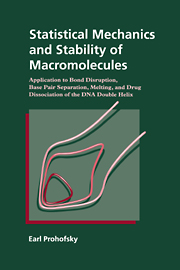 Statistical Mechanics and Stability of Macromolecules
Statistical Mechanics and Stability of Macromolecules Book contents
- Frontmatter
- Contents
- Preface
- 1 Introduction
- 2 Macromolecular stability
- 3 Lattice dynamics
- 4 Effective phonon theory
- 5 Premelting disrupted chemical bonds
- 6 Cooperative melting
- 7 Strained chemical bonds: salt and pressure effects
- 8 Bond disruption and conformation change: B to Z conformation change in DNA
- 9 Hydration effects: structural water
- 10 Helix with daunomycin intercalated: increased helix stability and daunomycin-DNA binding constant
- 11 Nonrepeating DNA
- 12 Cutting and splicing: junctions, inserts, and the replicating fork
- 13 Interaction between a helix and a single attached molecule
- 14 Energy considerations in bond opening
- Appendix 1 Helical lattice dynamics
- Appendix 2 Density matrix and effective phonon theory
- Appendix 3 Green functions
- References
- Index
6 - Cooperative melting
Published online by Cambridge University Press: 16 September 2009
- Frontmatter
- Contents
- Preface
- 1 Introduction
- 2 Macromolecular stability
- 3 Lattice dynamics
- 4 Effective phonon theory
- 5 Premelting disrupted chemical bonds
- 6 Cooperative melting
- 7 Strained chemical bonds: salt and pressure effects
- 8 Bond disruption and conformation change: B to Z conformation change in DNA
- 9 Hydration effects: structural water
- 10 Helix with daunomycin intercalated: increased helix stability and daunomycin-DNA binding constant
- 11 Nonrepeating DNA
- 12 Cutting and splicing: junctions, inserts, and the replicating fork
- 13 Interaction between a helix and a single attached molecule
- 14 Energy considerations in bond opening
- Appendix 1 Helical lattice dynamics
- Appendix 2 Density matrix and effective phonon theory
- Appendix 3 Green functions
- References
- Index
Summary
First and second order transitions
First order transitions occur between two distinct phases of a system. One phase is observed until a critical value of control parameters, such as temperature or pressure etc., at which the two phases coexist, and the system converts to the other phase for further changes in the control parameter. In some cases the system can display superheating or supercooling where the system can be coaxed into remaining in the wrong (nonequilibrium) phase past the value of the control parameter where the transition should have occurred. At the point where the two phases coexist one can experimentally observe an interface between the two regions of different phase. The change in phase is obvious; one can tell which side of the interface has which phase. Some intrinsic parameters of the system, therefore, have to undergo a discontinuous change. For example in the liquid–gas transition, the liquid is compact whereas the gas fills the available space. The density changes drastically and discontinuously with phase. A parameter, like the density for the liquid–gas transition, that unambiguously defines a phase, is called an order parameter. The name comes from studying ferromagnetic transitions where the alignment or order of the spins defines the phase.
Second order transitions don't have discontinuities in a primary parameter. They only have discontinuities in derivatives of primary observables, such as the specific heat, and that leads to the name second order.
- Type
- Chapter
- Information
- Statistical Mechanics and Stability of MacromoleculesApplication to Bond Disruption, Base Pair Separation, Melting, and Drug Dissociation of the DNA Double Helix, pp. 88 - 102Publisher: Cambridge University PressPrint publication year: 1995


